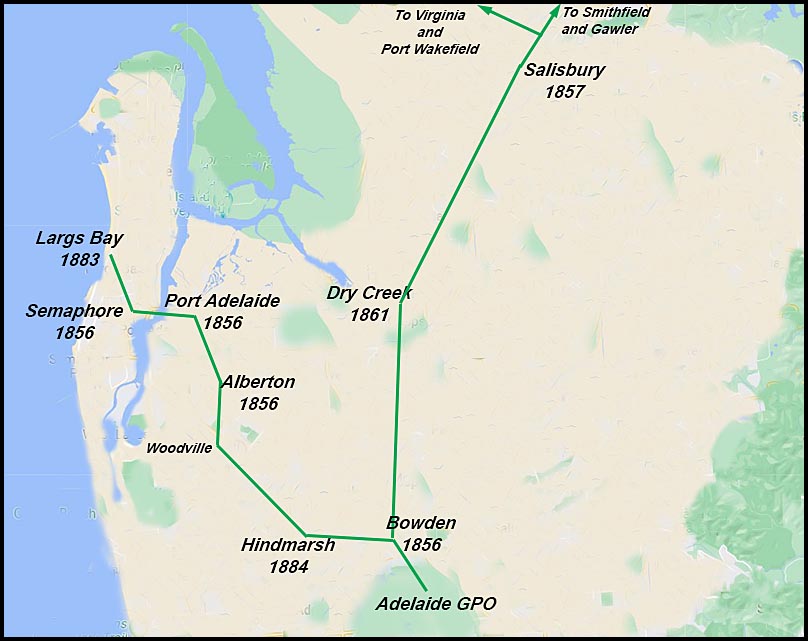The first telegraph line in S.A. - 1856.
- Australia 1901-1988
- New South Wales
- Overview of NSW
- Telegraph lines
- Telegraph Offices
- Date stamps
- Forms
- Envelopes
- Instructional annotation
- Collect
- Delayed
- Free
- Immediate Urgent
- Reply paid
- Rates
- Stamps
- 1871 Telegraph stamps
- 1885 proposal
- 1893 proposal
- Queensland
- South Australia
- Tasmania
- Victoria
- Western Australia
- International
- Special aspects
Charles Todd arrived in Australia on 4 November (aboard the Irene with his young 17 year old bride Alice) to take up his appointment as (astronomical) Observer and Superintendent of Telegraphs. Coincidently, a magnetic telegraph ordered by the Government and intended for use on the same line, had also arrived from England on that day.
Three weeks later - on 26 November 1855 - the line of Macgeorge - was opened by James Macgeorge as a private line serving the public and the business community between Adelaide and Port Adelaide. The line was regarded most negatively by the Government. Todd had literally walked off the ship from England to take up his appointments but encountered a major problem which the Government expected him to solve.
As noted elsewhere, MacGeorge had actually ignored the South Australian Government’s declaration that only the Government could own and operate telegraph networks. Nevertheless, his effort was an immediate commercial success and, in effect, he created Australia's first privately-owned telegraph network. From then - and throughout the following century - Colonial governments (and later the Commonwealth Government) opposed the idea of private ownership in communications. Consequently in January 1857, the South Australian Colonial Government decided it would purchase McGeorge’s line for £80 and immediately dismantle it - thus preventing further private entrepreneurial activity.
The Government line begins.
To demonstrate the Government's ability, Todd commenced the construction of a Government line. In the South Australian Register of 27 November 1855, tenders were called for the construction of an Electric Telegraph Station on Le Fevre's Peninsula.
Construction began in Adelaide in December 1855, opened to Port Adelaide on 18 February 1856 and was then extended to Semaphore on the Le Fevre's Peninsula in early March. Later in the year, Telegraph Offices were also opened at Port Adelaide Railway Station as well as at Bowden and Alberton.
 |
Two construction approaches were used:
- between Adelaide and Port, the line was above ground. Four wires were suspended on posts of Singapore cedar or Swan River mahogany with 32 posts to the mile. These posts were well charred and tarred where they entered the ground. The insulators were inverted cones of white porcelain.
- from the Railway Station in Adelaide to the Government Offices in King William Street, a six-wire cable was laid under ground in iron pipes - two lines being for railway use. . The same was done at the Port and, as well, 700 yards of submarine cable were carried under the creek to the Peninsula and to Semaphore.
The first experimental line in that colony was, as is generally the case with experimental lines, the most expensive. The nine miles from the City to the Port cost £3,024 - this sum including all fittings, materials and freight, as well as the erection of stations and the seven hundred yards of sea-wire submarine cable across the harbour.
Early days
The commencement of telegraphic business could not however be rated as auspicious. Receipts for the first day on the Adelaide-Port Adelaide-Semaphore line amounted to 5/3. This amount fell to 2/6 on the second day, to 1/9 on the third day and to 1/3 on the fourth.
This trend quickly reversed and the perceived usefulness com mercial value of the South Australian telegraphic system began to be reflected by the number of messages being transmitted:
- in the first month of operation, receipts were £8 and £88 in June 1857.
- in the 11 months to the end of 1856, 14,738 messages were transmitted over the Port line with receipts amounting to £366;
- from the opening of the Port line on 18 February, 1856 to 30 June, 1857, a sum of £791 was received for messages - and all Government and railway messages were transmitted free of charge.
- in this same period (so including about two months of the Adelaide-Gawler traffic on the northern line), a very significant 30,870 messages were sent. This was even more than had been sent in Victoria in 33 months up to December 1856.
- for the 1857 calendar year, 35,792 messages were transmitted and receipts totalled £1,184. Messages to Port Adelaide alone totalled £884.
For further details seeTodd's Report in the Public Works Report reprinted in the South Australian Register of 5 January 1858.
Lines were constructed in all directions according to various priorities, population, mining and business demands. In addition, a number of Telegraph Offices were opened on or near this line - for example Hindmarsh in 1884.
The development of these lines can be traced through the general map shown above.